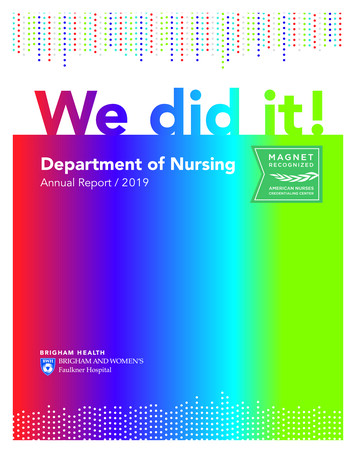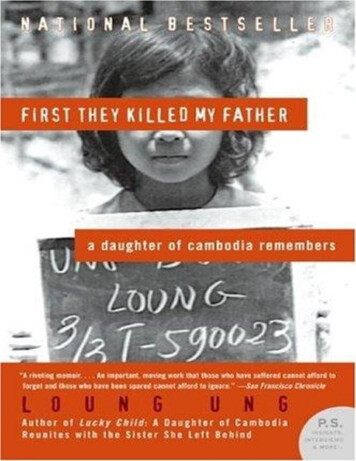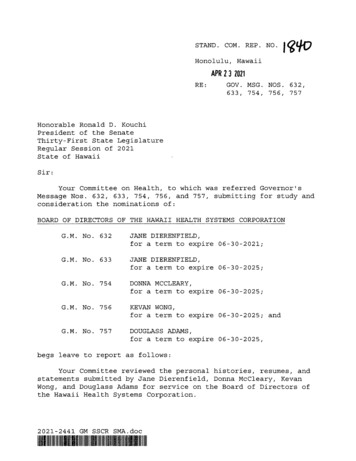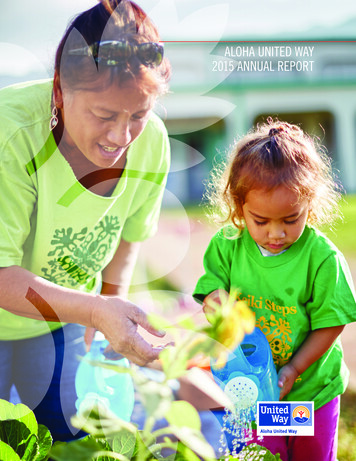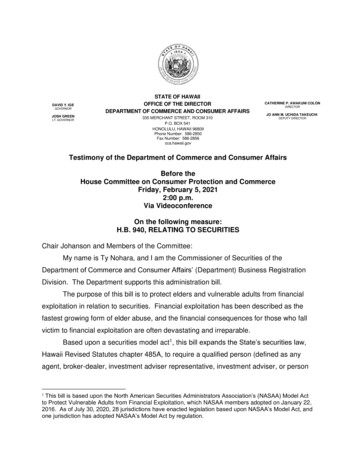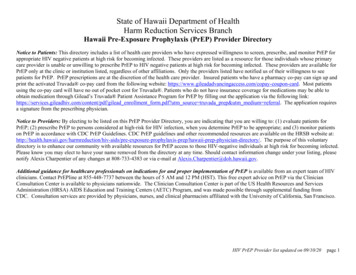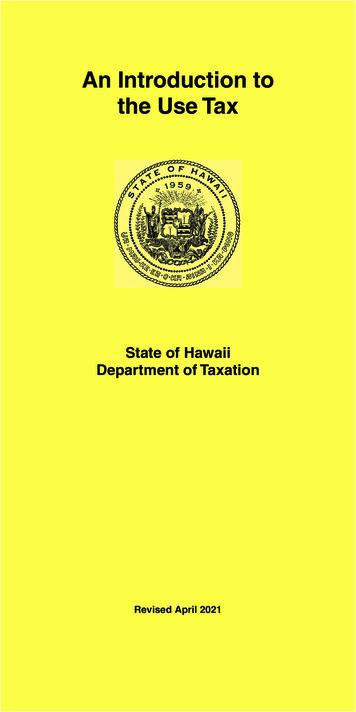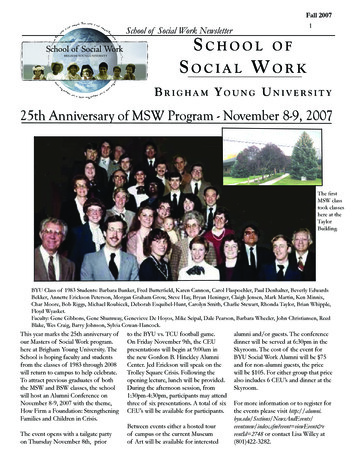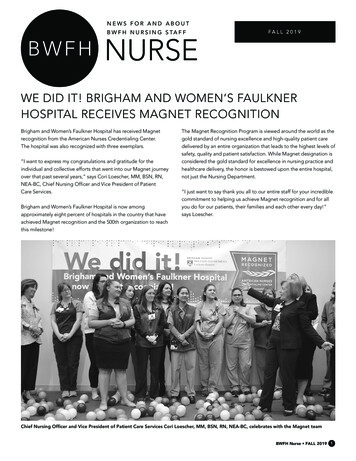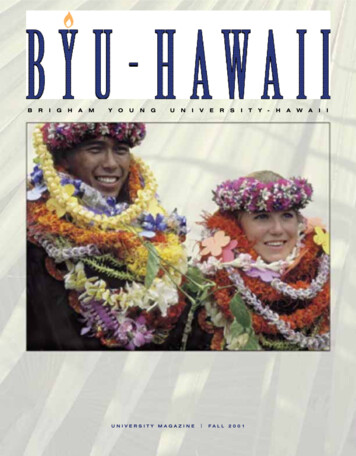
Transcription
BRIGHAMYOUNGUNIVERSITYUNIVMAGAZINE ERFALLSI2001TY-HAWAII
Meet the teamAS WE WORKED on this current issue ofthe Magazine the horrific events of September 11 intruded into all of our lives. Inone sense they highlighted our remoteness—located as we are in the middle ofthe earth’s largest ocean. Yet, overwhelmingly, we feel included, embraced, and avalued part of the diverse family that isAmerica.We are grateful for our prophet, Gordon B. Hinckley, and his loving counselthat sustains us in these turbulent times.We are grateful, too, for an earlierprophet, David O. McKay, who, in hisfounding vision of BYU-Hawaii, definedour mission and destiny. In the spirit of ourtime and place we express our gratitudefor the freedom, peace, and purpose weenjoy in our lives and work as members ofthe Church of Jesus Christ of Latter-daySaints and take heart from PresidentHinckley’s advice to the young adults ofthe Church given September 9, 2001:“Believe in yourselves as sons and daughters of God, men and women withunlimited potential to do good in the world. . . Believe in one another as the greatestgeneration ever yet to live upon the earth.”From one of the earth’s most beautiful islands we send our Aloha to you, ourreaders and friends everywhere.From top to bottom: Vernice Wineera, editor; Elder Wally Barrus, servicemissionary “photographer extraordinaire”accompanied by his wife, Sister ShirleneBarrus; Vaclava Svobodova, Intern photographer; and Randy Sasaki, graphicdesigner. 2University Magazine
EXECUTIVE EDITORV. Napua BakerVice President for University AdvancementUNIVERSITY MAGAZINEBrigham Young University -Hawaii / Fall 2001EDITORDr. Vernice WineeraALUMNI INFORMATIONRowena E. P. ReidAlumni Affairs DirectorGRAPHIC DESIGN AND LAYOUTRandy SasakiBYUH Press & Design CenterPHOTOGRAPHYWally Barrus, Vaclava Svobodova, AllisonWilliams, BYUH ArchivesIn This Issue4Interview with President Eric B. ShumwayExploring the role of the University in the 21st Century12 Von Orgill, Polynesian Cultural Center PresidentCHANGE OF ADDRESSTo continue receiving UNIVERSITYMagazine, please send address changes to:Rowena Reid, BYU-HawaiiBox 1951, Laie, HI 96762 USAemail: reidr@byuh.eduph. (808) 293-3648fax (808) 293-3491web page: http:byuh.edu.alumniUNIVERSITY Magazine is published twiceeach year by the University AdvancementOffice of Brigham Young UniversityHawaii. BYU-Hawaii is sponsored by theChurch of Jesus Christ of Latter-day Saints.It is a campus of Brigham Young Universityin Provo, Utah, and is presided over locallyby a president who reports to the BYUpresident on the main campus. Printed byHagadone Printing, Honolulu, Hawaii.Defining the foundations of the Center’s success20 Keith Roberts, Vice President for AcademicsLaying foundations of a Quality Education22 Distinguished Alumni AwardJoe and Susie Berardy, Entrepreneurs of the Year 200123 Alumni Updates23Lucia Lealaitafea Westin,24Burton K. Freitas24Antonio Petero24Grant Pearse25Michelle Moana Hippolite26Frank Hippolite26Deaths in Our Ohana27 Meet Tomorrow’s Leaders Today at BYU-HawaiiBy Ron TaylorFRONT COVERRobert and Aubrey Kekauoha, 2000graduates. Photo by Vaclava Svobodova.Fall 20013
Interview with PresidentEric B. Shumway4University Magazine
Exploring therole of theUniversity in the21st Century:President Eric B.Shumway answersmost-askedquestions1I envision our academic programs being stronger and stronger. Our ties with Provo willbecome more and more seamless. We draw from their resources, they draw from our experiences, and both of us are better for it. While we are described as “oneuniversity—two campuses”, our BYU-Hawaii mission will continue to be specific.Do you have avision of whatBYU-Hawaii willbe on its 50thbirthday in 2005?The Church is growing in many Asian countries and we have their students here. Othernations are not yet represented on campus but we will continue to have more diversity.Ten years ago there were no students from Mongolia here. This year we welcomed ourfirst students from Cambodia, our first from Papua New Guinea. Wherever the Churchis planted it grows and young people see BYU-Hawaii as a legitimate option in theirlives. I sincerely believe that the prophetic charges given by our leaders over the yearswill continue to resonate in everything we do. The numbers of U.S. mainland studentswill decline as Asian students increase. The U.S. students who do come will be older.They will stay and graduate because of the strength of our programs, not because of thebeauty of our beaches.We will have stronger majors in Business, Information Systems, Computer Services,Teaching English as a Second Language, and International Teacher Education. The university may offer graduate degrees in selected areas by 2005.Fall 20015
2How importantare the Arts inthe mission ofthis school?Extremely important! The fundamental strengths of a liberal arts education is to develop the mind, to increasebroad general knowledge, to develop thinking and communication skills, to foster in all of us a sense of artisticand natural beauty, and to learn through a number of experiences in the arts and sciences what it is to be human.And in the context of a gospel-centered environment tounderstand more thoroughly what it means to be children of God.July 21, 1954The First Presidency announced theHistoricalTimelineBYU-HAWAII/ PCC6University Magazineestablishment of a college inApril 1955Hawaii. Dr. Reuben D. Law, formerFebruary 12, 1955Military war surplus buildings wereDean of the College of Education atPresident David O. McKay presidedmoved to the site as temporary fa-BYU, was appointed President.at groundbreaking services.cilities.
3In what significantways doesBYU-Hawaiicontribute to thecommunitiessurrounding thecampus?4How does BYUHprepare itsstudents to returnto homelandsthat may beeconomically,politically, or inother ways inturmoil?5Can the Universityassist its studentstowards graduatestudies to helpprepare themfor their futurecommunity roles?Immensely. We produce many teachers for the state Department of Education and manysocial workers. BYU-Hawaii and the Polynesian Cultural Center remain most excitingplaces to visit for locals as well as tourists. We are very important to the communityeconomically. The combined budgets of BYU-Hawaii and the Polynesian Cultural Center and their construction projects presently underway make a significant contributionto the state economy.Kahuku High School enjoys the benefits of using our facilities as they hold their graduation ceremonies in our Cannon Activities Center, our pool for their swimming activities,our fields and other facilities as needed. Our Hawaiian Studies program provides community outreach, and other University entities enjoy a program of service-learningwhich embraces the community in projects such as planting taro at Kahana Bay, building a fish farm, working with the Bobby Benson Institute. As always, many of ourcampus activities are open to the community.One of the main things BYU-Hawaii does is providea sound education within the context of gospel values which produce people of integrity andconfidence. As Ambassador Choinhor from Mongolia to the U.S. said, “BYU-Hawaii is valuable to thefuture of nations like Mongolia because intelligenceand morality are the outcomes of an educationhere.” As with other institutions which international students attend, we teach many skills but beyondthis our students learn what morality-based leadership is; what the principles of democracy are; andthe importance of fairness, justice, and the rule oflaw to free societies. Furthermore, the returnabilityof our international students to strengthen theirpeople and “build up Zion” in their homelands is atop priority for our campus.We will offer our first graduate school scholarships thisyear. At least three BYUHgraduates this fall will receive them to do graduatework at Provo.April 12–14, 1956December 9, 1955January 1956The first school play, “Father’s BeenJune 1, 1956September 26, 1955The first student body electionsThe first varsity basketball team wasto Mars” was staged at the old Huk-The first commencement exercisesThe Church College of Hawaii offi-were held. Donald Manoa wasorganized. Frank Condie was theilau Building. Woodruff J. Deemwere held, with ten students receiv-cially commenced operation.elected president.coach.directed the play.ing Associate degrees.Fall 20017
6What is themost exciting orsignificant aspectof BYU-Hawaii?7In what wayscan BYU-Hawaiiemployees—faculty andstaff—helpcontribute to itsmission?8What part of yourjob gives you themost delight?To me there are at least two things. One, what I call the miracle of transformationamong students who before BYUH had so little hope or opportunity and who now seemto be perfectly fit for this kind of environment. They change and improve. Two, BYUHawaii is a wonderful blending of the multicultural, the intellectual, and the spiritualdimensions of learning—and in this regard it’s true in the Church that learning increases religiosity rather than decreases it. This was eloquently expressed by InnocentShumba at graduation last year. Honored as a Summa Cum Laude graduate—which heachieved in less than four years—he said: “Thank you for honoring me for these thingsbut I hope that I will be remembered for my testimony of Jesus Christ.”The best thing they can do is be excellent role models. Our students tend to look up toteachers and model their behavior, work habits, and interests. Faculty and staff shouldbe mentors in everything they do. Nearly all of them have students around them everyday. They can be advisors and correctors. I’ve seen some work supervisors influence students so profoundly that whenthey graduate they go into thatfield of work.Several things, first, the students—their strength, their testimonies, their gratitude. Second, telling the BYU-Hawaii story. When I look back at what President McKay andothers saw in their vision of this University I have to ask how much more did they see?We are fulfilling the prophecy but on the meager end of it. There is much more ahead.A third delight is to see the conversion of friends of the University who knew nothingabout BYU-Hawaii before—but who are now avid fans. A fourth is to see the studentshandle schoolwork, jobs, and new families with faith and grace.March 19598The Polynesian Institute was organ-August 1959September 19561958December 17, 1958ized to promote interest in and theDr. Richard T. Wootton was appoint-The first students from Tonga andThe first students from China andPresident David O. McKay dedicatedstudy of Polynesian cultures undered President of CCH. He servedSamoa arrived.New Zealand arrived this year.the permanent campus.the chairmanship of Jerry Loveland.until 1964.University Magazine
March 1960February 23, 1961The Polynesian Institute of CCHWASC grants full four-year accredi-January 30, 1962produced “Polynesian Panorama”,tation to CCH, noting “ChurchPresident Hugh B. Brown dedicatedFebruary 19, 1963August 2, 1964directed by Wylie Swapp, at Waiki-College provides an excellent envi-four newly constructed dormitoriesPresident Richard T. Wootton pre-Owen J. Cook, newly appointedki’s Kaiser Dome. This program wasronment for a small liberal artswhich brought the college’s board-sented the first David O. McKaythird president of the college ar-the forerunner of the PCC shows.college.”ing capacity to 928 students.Lecture.rived.Fall 20019
9Having come toadministrationfrom out of thefaculty, how wouldyou describe yourrelationship withthe faculty?10If you could wishone thing forBYU-Hawaii whatwould it be?(Chuckle) You probably should ask the faculty this question! Let me say that I have agreat reverence for what they do and take great satisfaction in knowing that I was partof the process in bringing some of the finest teachers in the Church to this campus.These are teachers who are devoted to students and have a profound commitment to theSavior and to their covenants.The faculty need to see their position as a sacred stewardship where the lives and futureof each student represents a whole posterity, perhaps generations. They need to be faculty who can sort out for the students the good from the evil. We have a faculty who arenot afraid to call evil evil rather than some euphemism that caters to one form of political correctness or another. They are faculty who recognize the over-archingcomprehensive reality of the Atonement of Christ and His mission in the world and theuniverse, and who can help create in students a sense of awe and gratitude. They canhelp our students see that conscientious learning is an act of worship. They are facultywho model every Christian principle in their lives, in their homes, in their classroomsand in their offices.I can’t say one thing—maybe three things! One, that we would enthrone the notion ofintegrity and competence in all that we do. Good people who are incompetent, not prepared or faking it, are really without integrity. Two, that we maintain a profound senseof mission in the light of President McKay’s vision. Three, that we cultivate a willingness to update ourselves, to always change for the better, to meet challenges, toprogress.April 23, 1968July 1968The library was officially named the Ralph E. Woolley Library. Brother Woolley, aThe first summer school programsuccessful architect and engineer, served as Hawaii Temple president, the firstwas conducted under the direction ofFebruary 17, 1969Oahu Stake president, and as a member of the first Board of Trustees of CCH. HeWylie Swapp. This year the first issueThe Asian Language Training Mission was officially opened to teach Oriental andhelped design and direct the construction of the Hawaii Temple and several otherof the TESL Reporter was publishedPolynesian languages. Kenneth J. Orton was called as mission president of thebuildings in Waikiki, including the Royal Hawaiian Hotel.with William Conway as editor.LTM, which was first located in Hale Malo dorm and later moved to Hale Pukuniahi.10University Magazine
11In what wayscan/does BYUHfunction as abridge to Asia, thePacific Islands,and Provo?12How do you definethe University’spartnership withthe PolynesianCultural Center inthis new century?We are a bridge to Asia based on longtime relationships of trust. Relationshipsare so important in our target area. Ourrelationships are proven, friendly, andon-going. I think we will always be asource of knowledge and understandingof diversity and the value of it to Provo.We will also continue to have opportunities to expand and validate internationalthings and contribute to the global dimensions of the gospel.The Polynesian Cultural Center is an extraordinary extension of our campus. Its mission is linked to the mission and destiny of the University. It not only preserves andportrays Polynesian cultures - it also provides valuable employment for hundreds of ourstudents. This employment is both financially rewarding and profoundly educational atthe same time.At the Polynesian Cultural Center the students learn valuable job-related skills in all areas of the business, from the accounting department to marketing, culturalpresentations and performance. They learn customer service skills, time management,and are able to develop the habits of mind and job performance which will carry themthrough their lives. Many of our graduates have claimed that their work experience atthe PCC was as valuable as their course work on campus. I see it all as one comprehensive educational experience.May 15, 1969October 16, 1970The first Honorary Doctorate award-1969–1970September 11, 1970Tupua Tamasese Lealofi IV, Primeed by the Church College of HawaiiPete Velasco of the CCH volleyball team was named to the Helm’s VolleyballPresident Joseph Fielding SmithMinister of Western Samoa, visitswas presented to Edward L. ClissoldHall of Fame. Velasco played on two U.S. Olympic teams and was an All-Ameri-visited campus to help commemo-CCH and is impressed with thefor his many valuable contributionscan ten times. Also in this period forty-two married student apartments wererate the 15th birthday of theChurch’s efforts to help Samoans andto the school.opened for occupancy. They later became known as Temple View Apartments.college.other Polynesians gain an education.Fall 200111
Von D. OrgillPolynesian CulturalApril 1971April 2, 1971February 11, 1972The CCH men’s volleyball team won the NAIA championship at the University ofOwen J. Cook retired and StephenStephen L. Brower was inaugurated. Elders N. Eldon Tanner, Howard W. Hunter,Dallas. Under the coaching of John Lowell, eight CCH players were named to theL. Brower was named as the newMarvin J. Ashton, and Neal A. Maxwell, Kenneth Beesley, Dallin H. Oaks, Henryall-tournament team: Pete Velasco, Dennis Largey, Jay Akoi, Ed Kalima, Rickpresident of The Church College ofEyring, Ferris Kirkham, Senator Hiram Fong, and Hawaii Governor George AriyoshiOlmstead and Hide Aieda.Hawaii.were in attendance.12University Magazine
Center PresidentTHE NEW president of the Polynesian Cultural Center has accepted the pace of thejob gracefully and this morning as we meet between airline flights—his arrivalfrom the mainland and my departure for the Pacific—his office is a quiet haven inour busy schedules. The morning light filters through slatted blinds to fill the room witha comforting peace. We settle down for a visit we have anticipated for some weeks.Von Orgill grew up in Grantsville, Utah, where, surrounded by relatives and friendshe worked on a farm operated by his uncle. He played all sports most particularly basketball and track and field, and he notes that he got his first “paying” job at the ripe oldage of five, when he took over a newspaper route from an older brother.Following his mission to Tonga he attended Brigham Young University, receivinghis Bachelor’s in Accounting (1974). Upon graduation he was employed by Arthur Andersen and Company in Los Angeles, and worked as a senior tax specialist when heentered graduate school. He received his Masters in Organizational Behavior (1980)from BYU, and worked with IBM for the next nine years in management roles in theplant, division, and corporate levels in Virginia, Maryland and New York.January 26, 1973President Marion G. Romney dedicated the Aloha Center, stating that TheOctober 2, 1973April 12, 1974Church College of Hawaii is “a living laboratory in which individuals who shareThe Aloha Center bowling alley do-Dan W. Andersen was appointed tothe teachings of the Master Teacher have an opportunity for developing appreci-nated by Dr. Ray and Nellie Reeveshead the college replacing Presi-ation, tolerance, and esteem for one another.”was opened.dent Stephen L. Brower.Fall 200113
“I saw a joy inliving that wasdifferent fromwhat I hadexperiencedbefore.”He left IBM in 1989 to operate his own consulting firm before accepting a positionthree years later as managing consultant and then senior vice president with the CoveyLeadership Center in Provo, Utah. Following Covey’s merger with Franklin Quest, heserved as executive vice president in charge of Franklin Covey’s Professional Services Group.Von Orgill was appointed president of the Polynesian Cultural Center June 1, 2000. At this 15-month mark of his administration, I ask himwhether he brings any emotional, intellectual or spiritual connectionswith Polynesia to his leadership role at the PCC, and he explains thathis two and a half year mission to Tonga as a young man was an experience that “fundamentally altered” his view oflife and the world.“Initially,” he says, “I found myself thinking I was going from one of the most advancedsocieties on earth to one of the most backwardcountries. As I look back on those days now, Ifeel embarrassed to even admit I had suchthoughts. I was so very naive. I simply didn’tunderstand what I was in for and what I wasgoing to learn and experience.“During my time in Tonga, I learned thatall the advancements in electronics, computing, transportation, communication, andmedical research can never replace what is such a natural part of the culture for the people of Tonga, such a natural part of their lives every day. They have, as a natural andnormal part of their lives, that which is really the essence of life, and the reasons for ourmortal experience. I learned in profound ways that material things matter little, if at all.In fact, I learned that the very advancements and material advantages of modern societycan be huge distractions from what really matters.“These wonderful people taught me that people, relationships with one another,and our relationship with God are really the things that make a difference in the end. Ofcourse, I knew this already, but in Tonga I saw the evidence of these convictions in action every day. I saw a general selflessness that I had not experienced previously . . . awillingness to give totally and completely to help another in need. I saw a joy in livingthat was different from what I had experienced before.” He pauses, “I saw faith exercised in ways that were to me miraculous, while to them, these incredible people, well,it was normal. The very fact that this way of living and being was so normal to themwas part of what taught me so much.“I feel as though the Tongans adopted me as one of their own and as a result, I havefelt a special connection with them and with all the people of Polynesia. That sense ofconnection grows every day. These experiences and the strong feelings I have aboutthese people and this place bring me a deep sense of humility and gratitude for the privilege of being here. I truly feel blessed by this opportunity.”The PCC employees, he observes, “do a marvelous job balancing the multi-faceteddynamics” of the park, and he notes that the team includes “true experts in the variouscultures, in business, in finance and accounting, in facilities and maintenance, in foodand beverage, in cultural performances, in sales and marketing, in human resources,and in computer systems—just in everything across the board.” He is particularlyApril 13, 1974President Spencer W. KimballJanuary 13, 1975October 19–20, 1976presided at commencement servic-June 12, 1974Wendell B. Mendenhall received anFebruary 13, 1976HRH King Taufa’ahau Tupou IV,es held at the PCC theatre andDallin H. Oaks, BYU president, visit-Honorary Doctorate of HumanitiesPresident Spencer W. Kimballmonarch of Tonga, was awarded anannounced that CCH would now beed campus to work on the transitionfor his work in the world widepresided at the groundbreaking of aHonorary Doctorate from BYU-known as BYU-Hawaii Campus.of the school from CCH to BYU-HC.Church building program.new library facility.Hawaii Campus.14University Magazine
pleased with the company-wide commitment to sharing expertise, understanding theCenter’s mission, and employees’ willingness to engage in constant assessment, recalibration, and redirection of the Center’s goals and strategies.“Our first and foremost desire is for each guest to feel the spirit of God while theyare on the grounds of the PCC” he says. “This happens as each of us lives the principlesof the gospel and is an example of righteous living because by so doing the experienceguests have here will be taken to a level that otherwise would be impossible. Of course,we want them to develop an appreciation for Polynesia and the special cultures thatmake up this part of the world. And we want them to enjoy themselves while they arehere and desire to return again and again.”In accomplishing these ends, he explains, Center employees want to provide visitors with the opportunity to interact with people from the islands and to taste, howeverbriefly, what it might have been like to live in a Polynesian village long ago. In this way,in many ways, he wants the visitors’ experience at the PCC to be very different fromother experiences they might have in Hawaii. “We want it to be more authentic, morerepresentative of Polynesia than other experiences available in Hawaii. Much of what weare doing and what we have planned for the future is designed with this in mind andour research indicates that most of our guests feel that the PCC has the most authentically Hawaiian and Polynesian experience available in Hawaii. They also rate theirsatisfaction higher here than with any other attraction in the islands.”Through consistent guest surveys, the Center staff has been able to determine thatthe primary reasons guests visit the PCC are that they want (1) an educational experience, (2) a cultural experience, and (3) an entertaining experience.“Our objective is to deliver on all three of these expectations,” he says. “We contin-Winter, 1978October 21, 1977The BYUH Institute for PolynesianJanuary 23, 1977Elder Bruce R. McConkie presidedStudies and the PCC published theElder Marvin J. Ashton presided over the Laie Hawaii Stake conference and an-at the dedication of the new libraryfirst issue of Pacific Studies, anounced the formation of the BYU-Hawaii Campus Stake, with Eric B. Shumwayfacility, a Parent Child Center, andcross-discipline scholarly journalas president, and Herbert K. Sproat and Weston J. White as counselors.physical plant buildings.with Robert D. Craig as editor.Fall 200115
ually strive to do each well and to balance these sometimes competing dimensions. Ourhope is that each guest will find in their experience much of value and interest, and willhave done so in a most enjoyable and memorable way. In the process, we fully expectguests to have an enriching cultural experience.”The PCC/BYU-Hawaii connection is crucial to the Center’s success, he notes.“There would be no Polynesian Cultural Center without the BYUH student employees.One of the primary purposes for the establishment of the Center was to provide a meanswhereby students from throughout Polynesia could work their way through school,while helping to preserve and portray the cultures from which they come.“These students, who make up 60–70% of our employee population, bring energy,vitality, and an abundance of the aloha spirit with them. They communicate to all whovisit here a warmth, friendless, kindness, hospitality, and love rarely seen or experiencedin other places. Most of our guests say they would love to take the feelings they havewhile visiting here and package them up and take them home with them. These feelingsThe Center and the UniversityTHE TWO PRESIDENTS, Von Orgill of the PCC and Eric Shumway of BYU-Hawaii, meet regularly to discuss challengesthe two institutions face and how best to optimize opportunities for progress. President Orgill explains this relationship:“There is very little that we plan or do that is not closely coordinated. We recognize that neither institution could existwithout the other. Of course, this isn’t just the case at our level. Atall levels of both entities we work hard to create a mutually beneficial, productive, and rewarding relationship.“The PCC is one of the most unique and wonderful places onearth. It plays an important role for BYUH, in the Church, and in theworld-community. There is a spirit here that is unequalled anywhere I have been or seen. The people are truly exceptional in amillion ways. Diversity is genuinely celebrated here and it works. Ithink it works the way the Lord intended. Laie is equally unique andwonderful. The heritage of this place and those who have helpedcreate the fulfillment of prophetic words here makes Laie a one-ofa-kind community. The influence of this tiny place extendsthroughout the world. It is a blessing and privilege to be here and tobe associated with the incredible people here.” June 1978The BYU-HC rugby team, coachedJune 13–25, 1978August 30, 1979by Inoke Funaki, toured the PacificThe First Presidency and seven general authorities attended the Hawaii TempleElder Marion D. Hanks presidedand played in Fiji, New Zealand,rededication after major renovations. After the first dedicatory service in the Tem-over the groundbreaking for the newTonga and Samoa.ple, other sessions were held in the BYU-HC auditorium.5,000-seat activity center.16University Magazine
are largely due to guests’ interactions with our students.”The experience is also beneficial for the students employed in the Center, as manydevelop an appreciation for their own heritage as well as a deep respect for the culturesof other people from around the world. “The student employees are necessarily and appropriately the core and the focus of all we do at the Center,” he says.Von Orgill is passionate about the partnership the Center and the University share.“The University is committed to building leaders who will have an impact for good inall the world. We are equally committed to building effective leaders. Students have amarvelous opportunity to apply their talents, skills, and knowledge while working atthe Center. Confidence is gained as they learn to perform their roles and responsibilities. Many have the opportunity to work directly in their particular fields of study herein the Center, acquiring valuable experience which will better prepare them for their future careers.” The two institutions are also now working together to dramaticallyincrease internship and cooperative work opportunities.September 6, 1979March 19, 1980BYU President Dallin H. Oaks an-January 25, 1980The University celebrated the sesqui-nounced an official change for DanDuring the groundbreaking for the new joint BYU-HC and PCC administrationcentennial of the Church with aAugust 1, 1980W. Andersen, from Executive Vicebuilding, President Dallin H. Oaks announced that President Dan W. Andersenprogram titled “Na Makua Mahalo Ia”Dr. Elliot J. Cameron succeeded Dr.President to President of Brighamwould be receiving a new assignment within the Church Educational System and(the Venerable Ones We Honor), withDan W. Andersen as president ofYoung University - Hawaii Campus.would be leaving during the coming summer.Dr. Ishmael Stagner
ph. (808) 293-3648 fax (808) 293-3491 web page: http:byuh.edu.alumni UNIVERSITY Magazine is published twice each year by the University Advancement Office of Brigham Young University-Hawaii. BYU-Hawaii is sponsored by the Church of Jesus Christ of Latter-day Saints. It is a campus of Brigham Young University in Provo, Utah, and is presided over .
